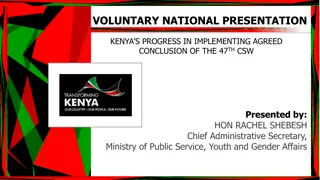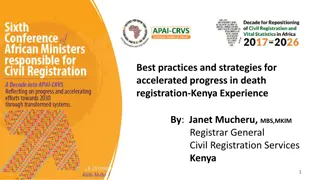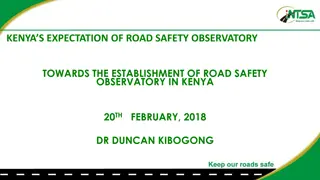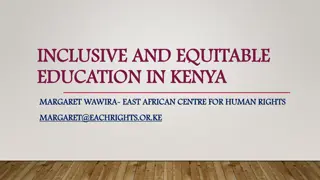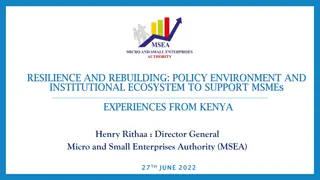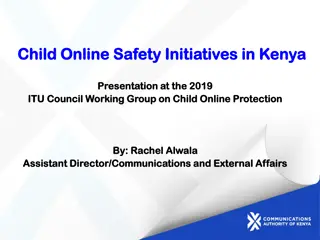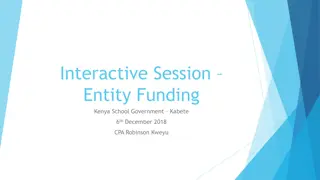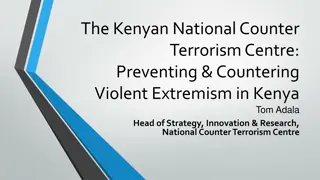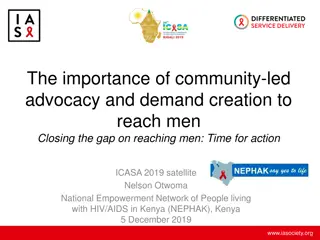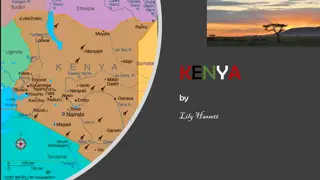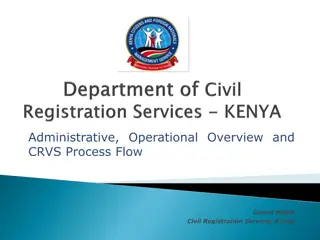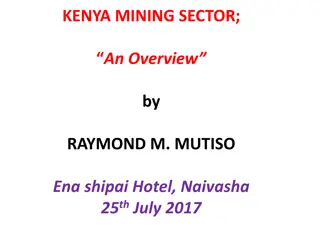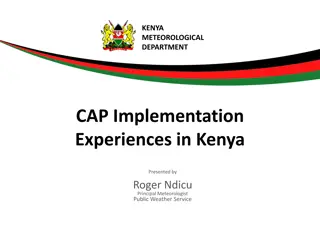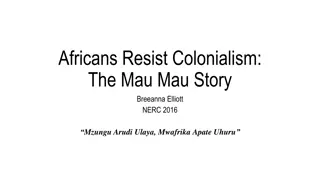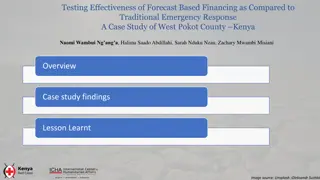Enhancing Learning Through Community Service Learning in Kenya
Acknowledging the lasting impact of engaging learners in community service, Kenya is shifting focus towards Community Service Learning (CSL) to foster holistic development and prepare learners for the workforce. Emphasizing experiential learning, CSL integrates classroom education with community service to empower learners and promote societal transformation. By combining education with practical experience, CSL aims to build essential skills and values crucial for national development, aligning with Kenya Vision 2030 and the Constitution's principles of social justice and sustainable development.
Download Presentation

Please find below an Image/Link to download the presentation.
The content on the website is provided AS IS for your information and personal use only. It may not be sold, licensed, or shared on other websites without obtaining consent from the author.If you encounter any issues during the download, it is possible that the publisher has removed the file from their server.
You are allowed to download the files provided on this website for personal or commercial use, subject to the condition that they are used lawfully. All files are the property of their respective owners.
The content on the website is provided AS IS for your information and personal use only. It may not be sold, licensed, or shared on other websites without obtaining consent from the author.
E N D
Presentation Transcript
. COMMUNITY SERVICE LEARNING COMMUNITY SERVICE LEARNING IN IN JUNIOR SECONDARY
Session Objectives By the end of the session, the participant should be able to: a) state the benefits of Community Service Learning (CSL) to the learner and the community, b)explain the steps in the CSL project c) demonstrate the ability to support learners in applying the CSL project strategies .
KWL 1. What I knowabout ......... 2. What I want to knowabout ............
ESSENCE STATEMENT It is increasingly being acknowledged globally that involving learners in community service has a lasting and positive impact on themselves and society at large. Community Service Learning (CSL) extends learning beyond the classroom into the community. . Learning happens through experiential learning strategies that integrate classroom learning and community service to enable learners to reflect, experience and learn from the community. CSL combines classroom learning and community service, allowing learners to work with community members to solve local problems and to learn from their own experiences.
CONTINUED.. Summative Evaluation Report of 2009 revealed that Kenyan curriculum was heavily academic and examination oriented, consequently limiting flexible education pathways for identification and nurturing aptitudes, talents and interests of learners, early enough to prepare them for the world of work, career progression and sustainable development. . CSL is therefore being emphasized as it enhances holistic development of learners (BECF, 2017). In addition, CSL promotes transformation of society with respect to embracing desirable values, including the ethos of providing service to the community (Taskforce Report, 2020). Kenya Vision 2030 emphasises the link between education and the labour market. Learners need to be supported to develop entrepreneurial competencies and strengthen partnerships with the private sector.
CONTINUED.. Kenya Vision 2030 s social pillar aims to build a just and cohesive society where social equity, a clean and secure environment are cherished. CSL will provide opportunities for empowering the citizens with the necessary knowledge, 21st Century skills and competencies to realize the national development goals. This is also in line with the Constitution of Kenya 2010 which upholds such values and principles as social justice, equity, inclusiveness and sustainable development (Republic of Kenya, 2010).
GENERAL LEARNING OUTCOMES OF CSL By the end of the Middle School level, the learner should be able to: a) Apply knowledge, values and positive attitudes to address needs and challenges in their immediate community. b) Utilise basic research, leadership, communication, financial and entrepreneurship skills to address challenges in their immediate community. c) Participate in relevant projects within the school and the community for mutual benefit and learning. d) Participate in local and national community activities as responsible citizens. e) Embrace moral values and positive attitudes in their day-to-day life. f) Appreciate diversity for harmonious living within the community. .
Principles of CSL in Basic Education The following principles will guide the implementation of CSL: . 1.Training and Continuous Professional Development 2. Community Empowerment and Engagement 3. Reflective Learning 4. Whole School Approach 5. Inclusivity
Implementation of CSL in Basic Education Early Years and Upper Primary(G4-6) Curriculum designs provide for age-appropriate CSL activities for each strand (where applicable) in every grade. The suggested CSL activities correlate with the subject matter. Learners engage in age-appropriate community-based activities are intended to support the achievement of learning outcomes.
COMMUNITY SERVICE LEARNING PROJECT FOR GRADE 7 CSL learning activities are domiciled in Life Skills Education. Below is the strand and its sub strands. 1.0 Definition of terms Community Service Learning 3.2 General Steps in a CSL project 3.3 Importance of CSL in the community 3.4 Accomplish a CSL project
CONTINUED. Life Skills Education at grade 7 will give an insight into the concept of CSL and give guidance on how to carry out a CSL project Learners will undertake one integrated group project in this grade. The activity will give learners an opportunity to practice the CSL Project skills covered under LSE.This CSL project will be assessed. The learning approach will take the form of a whole school approach, where the entire school community will be engaged in the learning process. Teachers will guide learners to execute a simple school based integrated CSL class activity. This activity can be done outside the classroom time.
The steps for carrying out a CSL project include: a) Identifying a problem in the community through research b) Planning to solve the identified problem in the community(What data collection tools will be used? Where will the data be collected? Target group) c) Designing solutions/strategies to address the identified problem-(how will the groups be divided ? What resources will be used?)
e) Sharing /reporting/ on findings of the project done f) Reflecting on own learning and relevance of the project d) Implementing the recommended solution(s) to address the problem
CSL Skills to be covered: Research : Learners will develop research skills as they investigate PCIs to address the activity, ways and tools to use in collecting the data, manner in which they will analyse information and present their findings. Communication:Learners will develop effective communication skills for as they engage with peers and school community members. These will include listening actively, asking questions, presentation skills using varied modes etc. Citizenship: : Learner will be able to explore opportunities for engagement as members of the school community and providing a service for the common good. Leadership: Learners develop leadership skills as they take up various roles within the CSL activity. Financial Literacy Skills: Learners consider how they can undertake the project as well as sourcing and utilising resources effectively and efficiently. Entrepreneurship: Learners consider ways of generating income through innovation for the CSL class activity.
Continued In carrying out the project, it is expected that the learners will use knowledge and skills learnt in various subjects. This in essence will bring about the aspect of integration of CSL. An example: Learners may do a project that seeks to find ways of conserving water in the school community. They may use knowledge and skills learnt in various subjects to carry out the tasks in the project as shown .
Strategy to carry out project task Write simple questionnaires to seek the school community members views Knowledge /skill used Learnt from which subject Writing skill English Analyse the questionaries Finding percentages Mathematics Do posters advocating best practices on water conservation in the school Painting/graphic design Visual arts Create songs /dances advocating best practices on water conservation in the school Making dance costumes Performing arts
COMMUNITY SERVICE LEARNING PROJECT FOR GRADE 8 Learners will prepare for an integrated CSL group project. This project will have milestones that will be documented and assessed. They will: i. Identify a problem in the community through research ii. Make plans to solve the identified problem in the community(What data collection tools will be used? Where will the data be collected? Target group) iii. Design solutions/strategies to address the identified problem- (how will the groups be divided ? What resources will be used?)
Learners will carry out an integrated project done in group work. The project will be a continuation of Community Service Learning activity at grade 8 and will focus on implementation, showcasing and reflection as follows: They will: i. Implement the recommended solution(s) to address the problem ii. share /report/ on findings of the project done iii. Reflect on the learnings and relevance of the project
CSL is a core, stand-alone subject. Each learner will be expected to carry out at least 135 hours of community service throughout their three years in senior school. Identified individuals assigned to support the learner undertaking the community service will sign a logbook against the hours served. The learner will be provided with a log book developed by KICD. The capstone CSL project will form part of the summative assessment.
Self Self- -Reflection Reflection 1. I learnt . 2. I need to learn more about . 3.How I will apply what I have learnt Suggestions I have for improvement of the session Upload your responses on https://forms.office.com/r/7nHVcLMZrt Facilitators to use this link to View Responses: https://tinyurl.com/KWL-Facilitators




